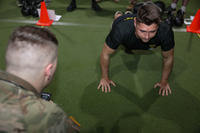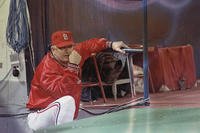The perfect uniform doesn't exist, but the Operational Camouflage Pattern uniform comes close. The OCP might be the best uniform the Pentagon ever engineered, and the Space Force is lucky to have it.
But when the newest military branch tweeted out a sneak peek of its commanding officer's OCP uniform, the Twitterverse questioned why the Space Force needs camouflage at all.
Despite its name, Space Force is going to be Earthbound, so it makes sense to use a camouflage pattern. And for many reasons, it also makes sense to adopt the same uniform used by the other branches of service.
Developing a new uniform is about much more than choosing colors. The camouflage pattern is actually one of the lowest-level concerns the Pentagon has when creating a new uniform, according to author Mary Roach. Her book "Grunt: The Curious Science of Humans at War" took a deep dive into how uniforms are designed at the Natick Soldier Research, Development and Engineering Center.
Related: 7 Uniforms the Space Force Should Have Borrowed
Natick Labs, as the center is commonly called, is based in Natick, Massachusetts. Here, everything from body armor to Meals, Ready to Eat is tested for almost every conceivable situation. Anything the military uses goes through a rigorous development process.
This is especially true for uniforms.
When the Army Combat Uniform was developed, its fabrics were tested for everything from flame resistance to tensile strength. When the fabric did burn, Natick made sure it wouldn't create harmful fumes. It then went through a series of functionality and endurance tests.

Uniform fabrics are also tested for their performance under extreme air pressure and explosive bursts; tearing with regular use; and their ability to hold in heat in the winter or release it in the summer. Fabrics would ideally release moisture as well, while holding back chemical agents and sand fleas. And it's a huge plus if they're antimicrobial and well-fitting.
The scientists at Natick test everything using mathematical models. The Doriot Climatic Chamber at Natick can recreate the most extreme of weather conditions. And there's a laser -- dubbed "Big Scary Laser" by the scientists -- that simulates the blast of an improvised explosive device. There's also the Nu-Martindale Abrasion and Pilling Tester that checks how fabric stands up to everyday usage.
Everything possible is tested on the fabric, from washers and dryers to mustard and ketchup. Natick even test things more likely to end up on a working uniform, such as motor oil and diesel fuel.
Once a material has been tested for flammability, endurance, resistance to liquids and whatever else Natick's scientists want to throw at it, the uniform still has to be designed. Items not only need to be comfortable; they also need to look cool.
"It's key that you design something that's kind of sleek and cool," one scientist told Roach. "Because otherwise, they're not going to want to wear it."
Then you must consider who will be wearing a uniform. Is it for a sniper? Will a zipper work? Would velcro be stealthier for special operations? Even the buttons on uniforms are engineered to perfection, as military inspectors use a rigorous, 22-page button specification system.
After the fabric and fasteners are chosen, the Pentagon leadership must choose a camouflage pattern. This is also much more difficult than one might expect.
Patterns can be engineered and patented, like the Marine Corps' MARPAT (short for Marine pattern). Or they can be chosen by a general officer, like the Army's hated Universal Camouflage Pattern from 2009, which Roach says wasn't even one of the 13 options Natick was testing.
There are also political considerations. Before the 2014 National Defense Authorization, each service could choose its uniform pattern. But the 2014 NDAA implemented a policy that no branch could roll out its own camo without the other branches using the same, with two exceptions: A service secretary can adopt a new camo uniform already being used by another service or the defense secretary could provide a waiver for new camo based on "unique circumstances or operational requirements."
Rolling out a new uniform can take anywhere from 18 months, as in the case of the Marine Corps' MARPAT, to six years, as with the Army's OCP uniforms.
Cheers to the Space Force for avoiding all that.
-- Blake Stilwell can be reached at blake.stilwell@military.com.
Want to Learn More About Military Life?
Whether you're thinking of joining the military, looking for fitness and basic training tips, or keeping up with military life and benefits, Military.com has you covered. Subscribe to Military.com to have military news, updates and resources delivered directly to your inbox.















